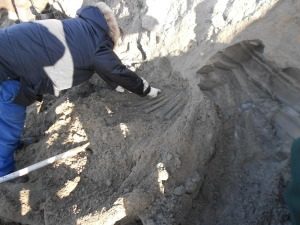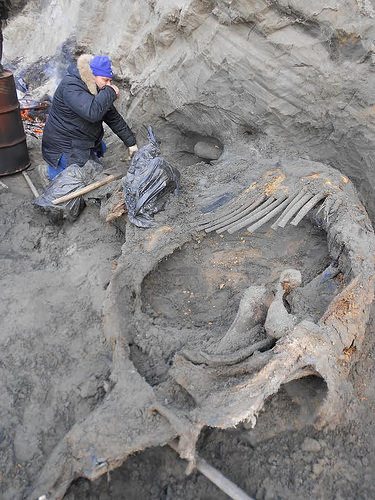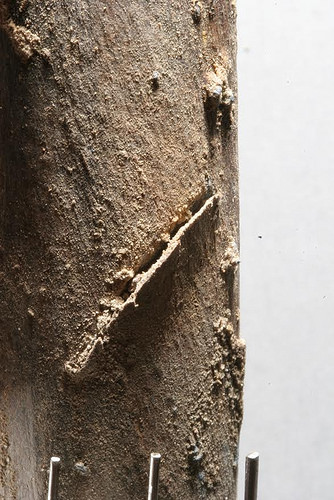
Recently excavated remains of a Siberian Arctic mammoth show signs of weapon-inflicted injuries by humans, say scientists, suggesting a human presence in the Eurasian Arctic ten millennia earlier than previously thought. It provides perhaps the oldest known story of human survival in the Arctic region, radiocarbon dating a human presence there to roughly 45,000 years ago, instead of 30 – 35,000 years ago, as previously thought.
Led by Alexei Tikhonov of the Russian Academy of Sciences in St. Petersburg, Russia, a team excavated a carcass of a woolly mammoth in 2012 from the frozen sediments of a coastal bluff near Sopochnaya Karga (SK), on the eastern shore of Yenisei Bay in the central Siberian Arctic. The find came to Tikhonov’s attention after it was initially stumbled upon by Evgeniy Solinder, a school-boy who was spending his summer with his parents who were working at a nearby weather station. Excavations quickly followed in September/October of 2012, after which the excavated remains were sent for cold storage in nearby Dudinks and then shipped to St Petersburg in early May of 2013.
________________________________________
SK mammoth unearthed. Sergey Gorbunov is excavating the left side of the carcass in the head area. Photo by Aleksei Tikhonov
____________________________________________________
Paleolithic records of humans in the Eurasian Arctic are relatively scarce. Only a few sites in this region have yielded clues to an early human presence. In mainland arctic Siberia, the site of Berelekh, discovered by Nikolay Vereschagin in the early 70s, was for years the location yielding the oldest evidence for human migration into the arctic regions. It dated to about 13,000 years ago. But in 2001 another site in the region, known as Yana, produced evidence of a human presence dating back to about 27,000 -30,000 years. Excavated by archaeologist Vladimir Pitulko, also of the Russian Academy of Sciences, it yielded tools made from rhinoceros horn and mammoth tusk, as well as hundreds of other stone artifacts including choppers, scrapers and other biface implements. “But I never thought that even this was the final age estimate for human migrations into the arctic,” said Pitulko. “Now we have much older evidence which goes back at least 45 thousand years. The [new Yenisei Bay] site is much older than everything known before in the arctic regions, and it is clearly located farther north from the areas where sites of that age have been found. It is about 20 degrees north (about 1900 km, or 1300 miles) of any site of comparable age…… and this is a big change.”
Using radiocarbon dating and other techniques, Pitulko and other colleagues closely examined the SK mammoth bones, which included the mammoth’s tibia bone, ribs, right tusk, and mandible. The mammoth’s bones exhibited a number of unusual injuries on the ribs, right tusk and mandible, all showing clear signs that they were inflicted with human-made implements. “The bones retain a number of damages resulting from human contact, both peri-mortem and post-mortem,” says Pitulko. “Most of them resulted from a hunting and/or butchering event. These damages are located on the left scapula, several ribs, and jugal bone. They are clearly related to the death of the animal which was killed and then partly butchered. They probably used a part of the prey, but most of the mammoth body was left on the ground.”
________________________________________
Cut mark on the SK mammoth 5th left rib. Photo by Pavel Ivanov
_________________________________________________
Aleksei Tikhonov (left) and Vladimir Pitulko discussing injury on the jugal bone of SK mammoth at Zoological Museum (RAS), St Petersburg. Photo by Pavel Ivanov
___________________________________________________
These findings leave no doubt, say the study’s authors, that people were present in the central Siberian Arctic by about 45,000 years ago. At this time, according to Pitulko, mammoth hunting by modern humans became a critical element in human survival in the harsh environment and lanscape of what is today Siberia, similar to the role buffalo played for Native Americans in North America. Removed from the hunted dead carcasses of their mammoth prey, “ivory became a substitution for materials used for shafts and points long and strong enough for killing large animals, not necessarily the mammoth,” said Pitulko. “Such tools are found elsewhere in the Upper Paleolithic, and this includes even full-size spears of ivory which are known from [the sites of] Sunghir, European Russia or from Berelekh, Siberia. This innovation became a really important discovery for humans and finally helped them in surviving and settling these landscapes.”
Thus, according to the study report authors, advancements in mammoth hunting likely allowed humans to survive and spread widely across northernmost Arctic Siberia at this time, representing an important cultural shift – one that likely facilitated the arrival of humans in the area close to the Bering land bridge, providing them an opportunity to enter the New World before the Last Glacial Maximum.
“This is especially important for questions related to the peopling of the New World, because now we know that the eastern Siberia up to its arctic limits was populated starting at roughly 50,000 years ago,” says Pitulko. “Until 15,000 years ago, sea-level (though changing) still remained low, which is clear from appropriate dates on terrestrial animals in the New Siberian islands. This presumes that the Bering land Bridge existed probably most or part of this time, so the New World gate remained open.”
Could modern humans have crossed over to the New World from here in these early times?
“Probably yes,” says Pitulko.
Future archaeological finds may provide additional clues to answering questions within this widely debated topic.
_________________________
An in-depth, full feature article about the Siberian mammoth findings will be published in the upcoming spring issue of Popular Archaeology magazine.
Some parts of this article were adapted and edited from the subject Science magazine press release.
________________________________________________________
“Early human presence in the Arctic: Evidence from 45,000-year-old mammoth remains,” by V.V. Pitulko; A.N. Tikhonov; P.A. Nikolskiy; and K.E. Kuper at the Russian Academy of Sciences inSt. Petersburg, Russia; E.Y. Pavlova at the Arctic and Antarctic Research Institute in St. Petersburg, Russia; and R.N. Polozov at the St. Petersburg Pediatric Medical University in St. Petersburg, Russia. Published in Science, the publication of the American Association for the Advancement of Science.
________________________________________________________
In addition, the latest Popular Archaeology ebook is now available.
______________________________________________
Travel and learn with Far Horizons.
____________________________________________
This richly illustrated issue includes the following stories: Two remarkable discoveries that are shedding light on human beginnings in Africa; a traveling exhibit and an archaeological site that show how knowledge is more valuable than gold; a Spanish cave and a unique burial that are offering a tantalizing glimpse on the lives of Ice Age hunter-gatherers in Europe; the stunning visual reconstruction of an ancient Roman town; enlightening new finds at a remarkably well-preserved site of ancient Hellenistic-Roman culture overlooking the Sea of Galilee; rare finds that are shedding light on occult practices among ancient Greeks in Sicily; and an overview of the overwhelmingly rich archaeological heritage of Britain. Find it on Amazon.com.












